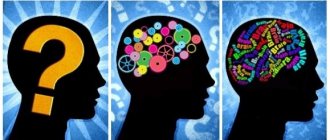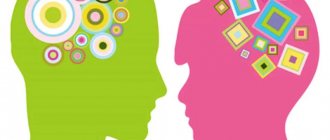Main points
The term “associationism” was introduced in the 17th century by the English thinker Locke. The concept itself became widespread half a century later, although the method of representing the work of the brain using similar images was described by Aristotle and Plato. Representatives of associationism endowed this principle with the role of the leading or only mechanism for the activity and development of the human psyche and consciousness.
It is noteworthy that for Locke, the founder of the empirical study of the psyche, all the phenomena of mental activity he examined related to the individual experience of a particular person, that is, the scientist consciously excluded from his research the essence of the soul and its influence on the personality.
Are you ready to stop thinking about your problem and finally move on to real actions that will help you get rid of your problems once and for all? Then perhaps you will be interested in this article .
Locke considered association to be the key mechanism for the emergence of complex ideas. The associationist theory included any complex thoughts (decisions/ideas) that “are often combined in such a way that they cannot be separated later” as a combination of ideas that are incorrect, that is, not consistent with the natural existence of a person.
An example of an association according to Locke is:
- sympathy;
- superstitions;
- antipathies.
The philosopher introduced the term in a very limited way. This was followed by active development of this mechanism of consciousness, which resulted in the emergence of associative psychology.
Locke approved the following scheme for the emergence of ideas through association:
- Sensations in the process of development precede mental activity.
- Simple ideas are combined through associations into more complex ones.
- Experience becomes the basis of knowledge, the sources of experience are reflection and sensations.
- There are no innate associations.
The concept began to be actively used in pedagogy, and over time it was developed in personality psychology. The psychological school of associationism seeks to establish an exclusively causal study of individual behavior.
The direction is based on the thesis about the sequence of ideas that reflect the impact of external factors on a person.
Very strict postulates have been replaced by theories that originate from the ideas of Rousseau and assign a key role in the formation of personality to the internal features of human development.
By the beginning of the 19th century, the principles of associationism were formed:
- the concept of soul is something capable of knowledge;
- the psyche consists of the simplest elements - sensations;
- complex thoughts arise from associations from simple parts;
- all knowledge about the soul is the result of introspection. A person can only study his own world; the inner spiritual life of another person is not accessible to outsiders.
For associationism, each person is represented as a loner who lives in a community of loners. The inner world of the individual is opposed to the external environment, and there is a hard line between them.
Advances in science at the turn of the 19th and 20th centuries brought changes to the perception of the psyche by associationists. Some scientists have introduced additional aspects to the study of human mental activity.
Thus, Darwin changed the interpretation of the manifestation of emotions, Sechenov developed the doctrine of brain reflexes.
In modern psychology, associationism is considered an important movement in which a strictly causal approach is applied to the study of human behavior. Association becomes the main mechanism of psychological activity of the individual. Thinking comes down to combining several images in memory with associations (by contrast with the object, by similarity, etc.).
V. Development of associative psychology
XVIII–XIX centuries
Associative psychology is the first scientific school of psychology, which laid the foundation for its separation from philosophy, the formation of a natural science paradigm and the search for objective methods for studying the psyche. Originating in England at the turn of the 17th – 18th centuries, associative psychology existed until the beginning of the 20th century as the dominant scientific direction of psychology, establishing associations as a universal explanatory principle of all mental activity.
Association as a phenomenon has been known since the times of Plato and Aristotle, but the English thinker T. Hobbes (1588-1679) was the first to give associations the power of the universal law of mental activity, describing mental life as mechanical associations between sensations from the external world and higher manifestations, including number and thinking. The empirical ideas of T. Hobbes were continued by his compatriot John Locke (1632 - 1704),
recognized as
the “father of empirical psychology”
and
. ”
If R. Descartes and other modern rationalists spoke about the innate nature of ideas
, then J. Locke asserted the exclusively lifetime nature of the formation of ideas through sensory experience.
J. Locke compared consciousness at birth to a blank slate (“tabula rasa”),
on which lifetime sensory
experience
leaves “
its writings
.
Having summarized all the known facts of the mental life of a child, Locke came to the conclusion that until the moment of learning,
the child does not have mathematical concepts, while the rationalists asserted their innate nature. A comparative analysis of the content of consciousness of people from different cultures and social classes also showed differences acquired during life.
Thus, J. Locke affirms life experience as a source of the formation of ideas,
in which he distinguishes
two types
:
1) external (sensory cognition, forming simple sensations);
2) internal (reflection of consciousness, as a result of which simple sensory sensations are transformed into complex ones).
J. Locke identified five mechanisms for transforming complex ideas from simple sensations:
1. Association
– (from Latin Assotiatio – connection) – random connections
between ideas arising due to their coincidence with each other in time and space.
2. Compound
(amount, accumulation).
3.Comparison
(comparison).
4.Generalization (
joining a particular case to an already known one).
5. Abstraction
(extraction, extraction).
associations exclusively as the only mechanism of the psyche
eliminating other mental operations from the zone of scientific analysis. Thus, J. Locke became the herald of associationism, which in English psychology of the 18th century was continued in two directions:
1. Materialism (David Hartley, John Tolland and Joseph Priestley).
2. Idealism (George Berkeley and David Hume).
internal experience as the basis of mental activity
, thereby affirming
the activity of consciousness,
regardless of objective reality.
Thus, a follower of Locke and the founder of an extreme form of subjective idealism,
J. Berkeley (1685 - 1753) argued that objects do not exist in reality, but exist only when consciousness perceives them, i.e.
“a thing is a complex of sensations”
, and
“to be means to be in perception.”
The Scottish idealist philosopher
D. Hume (1711 - 1776) goes even further in his reasoning and questions the existence of not only the physical world, but also the bodily competence of a person, namely, his senses.
Having questioned all the hypotheses known at that time about the source of the generation of sensations (God, the physical world and the senses), Hume did not find empirical and objective confirmation for them and stated that cognition is carried out without the participation of external experience and lies only in consciousness, which is closed in itself (like a monad in the teachings of G. Leibniz), itself generates and itself perceives sensations. Associationists of a materialistic orientation, on the contrary, considered the source of experience exclusively the external world, physically affecting the nervous system and mechanically generating associations between areas of the brain.
The first complete theory of associationism was the materialist concept of the English physician and philosopher David Hartley (1705 – 1757)
.
Based on the principles of mechanics of I. Newton,
as well as the scientific data of medicine and physiology, D. Hartley considered ideas as the result of associations between areas of the brain arising from vibrations of external influences in the nervous system.
In the structure of the psyche, Hartley identified two circles - large and small. Big circle
represented by a reflex arc and regulates behavior (mechanically, from vibrations of external influences).
The small circle
represents traces of external vibrations
in the brain
and regulates mental activity.
D. Hartley connected the strength of vibration traces with the degree of awareness, which became the first materialistic interpretation of the unconscious. All mental processes arise from associations between foci of vibrations in a small circle: thinking - from the association of an image and a word, will - from an association of a word and movement, memory - an association of traces with a word or image, etc. Thus, D. Hartley affirms the rootedness of associations in the bodily organization
and
the mechanistic nature of their formation
(mechanical excitation from vibrations, regardless of the content of ideas).
So, starting from highlighting the associative mechanism for the formation of complex ideas in the concept of J. Locke and ending with the explanation of all mental processes (from behavior to cognition) exclusively by associations in the theory of D. Hartley, we can trace the evolution of associative psychology, raising the principle of association to an absolute. Since the associative direction was the only independent and dominant one, in scientific psychological knowledge until the beginning of the twentieth century. The point of view is firmly rooted that there is nothing in consciousness except ideas and associations between them. In the 19th century, associative psychology was developed in the works of English thinkers James Mill and John Stuart Mill .
James Mill (1773 – 1836)
explained the work of consciousness as mechanical associations of elementary sensations that exist in the same quality throughout life and change only their place in the space of consciousness.
In accordance with this mechanistic approach, J. Mill’s concept was called “mental mechanics”
and in the evolution of associationism was its pinnacle.
J. Mill's son John Stuart Mill (1806 - 1873)
proposed a concept called
"mental chemistry".
The main principle of the work of consciousness, as before, remained associations of sensations, but they no longer arose mechanically, but as a result of the
active generation by consciousness of
qualitatively new mental states, different from the qualities of the original simple ideas. Such a departure from the mechanistic postulates of associationism contributed to its gradual degradation. Further development of associationism took place within the framework of physiology and evolutionary theory.
So, Alexander Bain (1818 - 1903),
author
of physiological associationism
, combined the ideas of associationism with the ideas
of hedonism
in its physiological aspect.
The main principle of the organization of thinking and behavior is associations between situations and reactions satisfying in given circumstances
.
Instead of mechanism, A. Ben introduces the concept of spontaneous activity
of the nervous system, which manifests itself in spontaneous movements that are repeated until they lead to a useful result.
A satisfying reaction is associatively fixed with the situation and the next time it reflexively arises in a similar situation. Thus, instead of mechanically consolidating associations, A. Ben introduces the idea of expediency. In addition, A. Ben adds creative
associations to the traditional types of associations based on similarity and contiguity in space and time.
Herbert Spencer (1820 – 1903),
the author
of the evolutionary theory of associationism
expanded the analysis of the psyche from its connection with the body to the relationship of the psyche with
the external environment.
In his concept, G. Spencer developed the ideas of
Charles Darwin’s
evolutionary theory that the main function of the psyche in the process of evolution is determined by the adaptation of the organism to the environment.
At the basis of adaptation (both biological and social), G. Spencer saw the formation of associations between external conditions and appropriate ways of responding
.
With the further development of psychology, associationism lost its theoretical significance and relevance, which contributed to the reorientation of research interest from theory to the practical study of associative connections : the laws of memory ( G. Ebbinghaus
), formation of skills (
behaviourism
), motivation of behavior (
psychoanalysis)
, associative experiment (
criminology, psychiatry
), etc.
In the 20s of the twentieth century, associationism as a separate movement disappeared. The point of view is taking root that association is not a mechanism of the psyche, but a mental phenomenon that itself requires explanation and disclosure of mechanisms (such as thinking, imagination, emotions, etc.).
Practical tasks
1. Create a matrix of ideas in the form:
"Comparative analysis of associative theories"
| Source of origin of associations | Mechanisms of associations |
| D. Hume | |
| D. Berkeley | |
| D.Gartley | |
| J.Mill | |
| J. St. Mill | |
| A. Ben | |
| G.Spencer |
2. Identify the authors of the passages below and justify your answers:
“Since <...> sensations are transmitted to the spirit thanks to the effectiveness of the material causes of the brain matter, as is recognized by all physiologists and doctors, it seems to me that the ability to generate ideas and excite them through association must also arise from material causes <...> And so as vibratory motion is more suited to the nature of sensation than any other kind of motion, it seems also more suited to the powers of generating ideas and exciting them by association. However, these faculties manifest themselves independently, as has already been noted, so that the doctrine of the association of ideas may become the foundation and guide for our future researches, whatever happens to the doctrine of vibrations.”
“When I say that the table on which I write exists, it means that I see and feel it; and if I were to leave my room, I would say that the table exists, meaning by this that if I were in my room, I could perceive it, or that some other spirit actually perceives it. There was a smell here - that means I smelled it; there was a sound - that means it was heard; were color or shape - that means they were perceived by sight or touch. That is all I can understand by such or similar expressions. For what is said about the unconditional existence of non-thinking things without any relation to their perceptibility is completely incomprehensible to me. Their esse is percipi, and it is impossible that they have any existence outside of spirits or thinking things that perceive them. Strangely, the prevailing opinion among people is that houses, mountains, rivers, in a word, sensible things, have an existence, natural or real, different from what the mind perceives them to be. But with whatever confidence and general agreement this principle may be affirmed, anyone who has the courage to subject it to examination will find, if I am not mistaken, that this principle contains an obvious contradiction. For what are these above-mentioned objects, if not things which we perceive through the senses? What do we perceive if not our own ideas or sensations? And is it not downright absurd that any ideas or sensations, or combinations of them, can exist without being perceived?
«Let's assume what the soul is, so
to say, a blank sheet of paper, without a single letter, without any ideas. How will anything appear on it? Where does this multifaceted content come from, which the industrious and unlimited imagination of man has drawn with almost endless ingenuity? Where does all the material of reason and knowledge come from? I will answer in one word: from EXPERIENCE. It is on it that all our knowledge is based and from which it originates.”
Control questions
1. Describe the basic principles and directions of associative psychology.
2. Name the ideological premises of associative psychology.
3. Describe the main ideas in the scientific work of J. Locke.
4. Describe the main ideas and theories of associative psychology of idealistic orientation (D. Berkeley, D. Hume).
5. Describe the main ideas and theories of associative psychology of materialistic orientation (D. Hartley).
6. Conduct a comparative analysis of the associative concepts “mental mechanics” and “mental chemistry”.
7. Reveal the essence and main ideas of the physiological approach in A. Ben’s associative theory.
8. Reveal the essence and main ideas of the evolutionary approach in the associative theory of G. Spencer.
9. Summarizing the material studied, name the main stages in the evolution of associative psychology and its place in modern psychology.
Recommended reading
Main
1. Zhdan, A.N. History of psychology. From Antiquity to the present day: Textbook for universities. - 5th ed., revised. and additional / A.N.Zhdan - M.: Academic Project, 2007. - 576 pp. - (“Gaudeamus”, “Classical University Textbook”). Recommended by the Russian Ministry of Defense.
2. Luchinin, A.S. History of psychology: textbook / A.S.Luchinin. – M.: Publishing house “Exam”, 2006. – 286 pp. (Series “Textbook for universities”).
3. Martsinkovskaya, T.D. History of psychology: Textbook for students. higher educational institutions - 5th ed., erased. / T.D.Martsinkovskaya - M.: Publishing house, 2006. - 544 S. Grif UMO.
4. Saugstad, Trans. History of psychology. From origins to the present day. Translation from Norwegian by E. Pankratova / P. Saugstad - Samara: Publishing house "Bakhrakh-M", 2008. - 544 pp.
5. Smith, R. History of psychology: textbook. aid for students higher textbook institutions / R. Smith. - M.: Academy, 2008. - 416 p.
6. Shabelnikov, V.K. History of psychology. Psychology of the soul: Textbook for universities / V.K. Shabelnikov - M.: Academic project; Mir, 2011. – 391 p. – (Gaudeamus). Vulture UMO.
7. Yaroshevsky, M.G. History of psychology from antiquity to the middle of the 20th century / M.G. Yaroshevsky - Publisher: Directmedia Publishing, 2008 - 772 pp. Recommended by the Ministry of Defense of the Russian Federation.
Additional
1. English materialists of the 18th century. – M., 1967. – T.1,2.
2. Anthology of fragments of classical texts of Western European philosophy [Electronic resource: https://www.auditorium.ru/books/1378/Berkeley/Ber.html] / Author. coll.: F.N. Blucher, S.L. Gurko, A.M. Rutkevich and others - Electr. Dan. - M., 2002. Berkeley D. Experience of a new theory of vision // J. Berkeley. Op. M., 1978.
3. Blonsky, P.P. Berkeley's doctrine of reality. M., 1925.
4. Bykhovsky, B.E. George Berkeley. M., 1970.
5. Ben, A. Psychology. – St. Petersburg, 1887.
6. Hartley, D. Selected Works. – M., 1934.
7. Hartley, D. Reflections on man, his structure, his duty and hopes // English materialists of the 18th century / Collection. Produced: In 2 vols. T. 2. M., 1967.
8. Hobbes, T. Leviathan. M., 1936.
9. Hobbes, T. Works: In 2 volumes - M., 1964. - Volume 1,2.
10. Kuznetsov, V.N., Meerovsky B.V., Gryaznov A.F. Western European philosophy, XVIII century. M., 1986.
11. Kuzmin, E.S., Yakunin V.A. Development of psychology in the 18th-19th centuries. L.: Leningrad State University, 1982.
12. Locke, D. Selected philosophical works: In 2 volumes - M., 1957.
13. Locke, J. Experience on human understanding // Works: In 3 volumes. T.1. M., 1985.
14. Narsky, I.D. David Hume. M., 1973.
15. Narsky, I.S. Western European philosophy of the 18th century. M., 1973.
16. Spencer, G. Works: In 7 vols. T 3. St. Petersburg. , 1898.
17. Hume, D. A Treatise on Human Nature, or an Attempt to Apply a Method of Reasoning Based on Experience to Moral Subjects // D. Hume. Treatise on Human Nature. Works: In 2 vols. M., 1995.
Association as connection
In the context of psychology, the word means the spontaneous connection of two objects in the brain. A connection between a memory and a fictitious image, between objects, can be created unconsciously without reference to a specific stimulus.
The appearance of connections is influenced by:
- external factors (smell, expression, visual image, sound);
- a person's own experiences and memories.
Life processes become the causative agent for the emergence of the association. Thus, unpleasant sensations in the stomach create an association with the food eaten.
A person’s thoughts can create several images or a chain of them. You can often notice that one thought “attracts” a second, a third, and so on. With this action, the brain presents a person with a connection of associations for a specific thought. The student solves the problem, in the process of calculations the audience and his classmates come to mind, this is followed by thinking about a specific person - the chain of thoughts can last indefinitely until the person forces himself to return to the original idea.
Types of associative connectives
Aristotle was the first to create a classification of images; his typology is also used by modern psychologists.
The thinker divided associative connections into 3 groups:
- Contiguity is a common type of image appearance that appears with the regular perception of several objects at the same time. The sound of water can be associated with relaxation, the aroma of baking - with home. This type of connectives includes verbal images that can be formed from idioms and sayings. Along with the emergence of the word “oak,” the association “mighty” may appear. Cohesion by contiguity is more often manifested through an actual connection between objects and/or actions. Stars are associated with the night, gloves with hands.
- Similarity . For such a connection to occur, objects must be similar in one or more characteristics: color, shape, emotional response of the individual to objects, etc. The sky evokes a connection with the sea, a snow-covered meadow with a white cloth.
- Contrast . The most complex type, little studied, unsubstantiated scientifically. A connection with an image arises in consciousness as a reaction to its opposition to an object or phenomenon. Most people remember winter when they mention summer, and when they hear the word “light,” they remember darkness.
At the end of the 19th century, the ancient classification was supplemented with a type of associations based on meaning. Such connections are the result of data analysis and the emergence of complex images in the human mind.
Semantic associations in most cases are individual and determined by personal experience. So, a person can associate a cough with winter, a train with the sea.
Personal connection tools
Associations are based on conditioned reflex reactions. Each external stimulus causes the appearance of a focus of excitation in the cerebral hemispheres of the cerebral cortex.
These factors are:
More than 9,000 people have gotten rid of their psychological problems using this technique.
- smells;
- words;
- sounds;
- tactile sensations;
- thoughts.
In the lesion, an electrical impulse passes through the neurons, which spreads across areas of the cerebral cortex. During this period, traces of previous passages of the impulse are activated and images that arose earlier upon contact with the object are recalled from memory.
The process of creating associations is necessary for the normal functioning of consciousness and increasing the efficiency of thinking, and is regulated by several tools:
- Memory and the information stored in it. Strengthening memory and expanding horizons create the opportunity for more quality associations to emerge. The result is the development of diverse and new connections.
- Imagination , which processes information, changes and combines combinations of elements in new forms of images. The work of imagination enriches a person’s memory; the resulting associations are used in thinking.
- The speed of passage of a nerve impulse or the occurrence of nervous processes, which regulates the speed of reflex reactions. Greater speed forces the brain to quickly create associations, the variety of which depends on the person’s level of knowledge.
- Unconscious . The process of creating connections is based on the sudden spread of excitation deep into the cerebral cortex and connects the subconscious to thinking. Due to the fact that a large amount of information is stored in this area of perception, associations are an opportunity to interact with the unconscious.
The set of associations is individual for each person, as it is created under the influence of the individual’s experience and knowledge.
Basic concept
If we bring together the ideas of all researchers in this direction, we can highlight the key principles of associative psychology:
- The soul was called and understood by researchers as consciousness. This was the first attempt to break away from the influence of theology on science and look at mental processes from a different angle.
- Our mental life is based on simple elements - these are sensations. They are basic and paramount.
- The researchers included feelings, thinking and ideas as secondary elements.
- According to the principle of associations, primary sensations are formed into secondary elements, i.e. the complex consists of a collection of simple elements.
- The more often an association is repeated, the more firmly it becomes entrenched in the psyche. It must be said that the frequency of repetition of associations is associated with emotional experiences, since they are the main stimulus for repetition, because the stronger the emotion, the stronger the connection will be.
Generally speaking, the associative theory of thinking reduced the entire thought process to the emergence of associative connections. Unfortunately, this theory could not explain such a process as creativity, calling it an innate, original function of thinking, although later researchers proved that this function is not innate.
The main and most noticeable limitation of this direction was the use of the method of introspection, or self-observation. Most of the conclusions were made by scientists based on an analysis of their consciousness and the processes that take place in it, while their assessment was given exclusively subjectively, which means it could not be extended to other people.
It must be said that in the 20th century this theory became obsolete and was replaced by new directions. But the concept of associations, which was introduced by these scientists, entered psychological science and is actively used to this day. For example, an association experiment was created based on this concept.
Namespace
There are well-established connections that are inherent in society and the linguistic environment. These images include the name space. Most of the modern names have ancient origins and are therefore associated with their original meaning.
In national cultures, names are often associated with a certain character trait (or appearance).
An example in Russian culture is the name Catherine; the word, due to the historical characteristics of the country’s development, receives a connection with “great” and with the original meaning “immaculate.”
The perception of the estate is influenced by its famous bearers. A famous example of an association in space named after Louis “the Sun” XIV is the French king. The rulers of the dynasty received this name over several centuries. Because of this, when many people mention the name, they associate it with royal attributes, Paris, France.
Many cultures have their own list of “unlucky names.” For example, these are the names of Christian martyrs - Tatyana, Fedor (although this tradition was not very widespread in Rus'). Such lists create negative associations that can spread and strengthen, deliberately predetermining the negative connotation of emerging connections.
A name space is a conditional set of generally accepted associations that can be positive or negative. This area is influenced by known bearers of a particular name.
Application of associationism in psychology
Suddenly appearing neural connections in the cerebral cortex have been used by doctors to identify mental disorders since the beginning of the 20th century.
The first psychoanalyst to draw attention to the connection with unconscious processes and emerging images was Freud.
His doctrine states that this very deep level of the psyche holds hidden desires and instincts that do not conform to public moral standards. Freud argued that suppression of desires causes phobias, mental and physical illnesses.
In modern psychological diagnostics, associations are used to determine the mental state of an individual.
Representatives of associationism, unlike Freudians, do not work with free images, but with organized phenomena that are controlled by a doctor.
The possibilities of using associationism in diagnostics are divided into 3 groups:
- Verbal connections and images . An example is the paired association test, in which a person needs to pair words according to their meaning (concept-meaning link) and according to phonetic similarity (starting with the same letter). Verbal tests offer the patient a set of words or expressions to which he needs to say the first word that comes to mind.
- Visual associations . A person studies the proposed images, in most cases abstract, then reports what the selected picture reminds him of. An example is the Rorschach test (Ink Blots).
- Creative impulses . To identify unconscious images, the subject is asked to draw anything or write a story on a specific topic. Creativity frees up thinking and allows the subconscious to connect to the work. Therefore, associations arise faster, and the process of studying already formed ones becomes easier.
Associationism considers images as the main resource of information about the individual and a prerequisite for the development of human intelligence and creative thinking.
Experiment
The ideas of Hartley and Hume, as well as other representatives of associative psychology, migrated to other directions and became the basis for new research.
One of these was the associative experiment in psychology, its development was carried out by E. Kremelin, K. Jung, W. Wundt and other researchers. This method is used both to study the interaction of people in a group and to study the internal processes of an individual. Thanks to the dynamics that are set in the experiment, the subject makes involuntary associations. And they are the basis for studying the thought process of both a given person and a group of people.
We recommend: Define your archetype
The association experiment is widely used in various fields of psychology to obtain reliable information:
It is used as a method of speech analysis, namely to study the vocabulary of the subject. To do this, subjects are presented with a list of words (about a hundred) and are asked to write their own association for each word (the first word that comes to mind) - no more than 10 minutes are allotted for this experiment. It is also used as part of psychophysiological studies to assess the correct understanding of stimuli
For example, a subject is presented with a certain stimulus (usually a word) and attention is paid to his physiological reaction - for example, how quickly the subject begins to salivate after the researcher says the word “lemon”. As a method of analyzing interaction within a group, to understand who is the leader and who is the outsider, as well as how cohesive the group is. It is interesting that the experiment in question is also actively used in criminology: with the help of associations, a suspect’s involvement in a particular crime is determined. In such cases, “reliable” are those associations that the suspect makes immediately, without thinking, since thinking can lead to false data.
As you can see, this experiment is used quite widely and in completely different areas of modern psychology. We should not forget that in many ways associations demonstrate not only the conscious part of our psyche, but also the subconscious. It is not for nothing that this method was used by psychoanalysts, whose subject of study was our unconscious.










